Pebo is a social robot designed to accompany solo climbers by storing their belongings, providing emotional support, and offering climbing suggestions. It moves around the bouldering gym and invites others to assist or climb together, fostering connections between climbers.
At Delfts Bleau, Pebo helps solo climbers feel engaged and connected with the community throughout their bouldering journey.



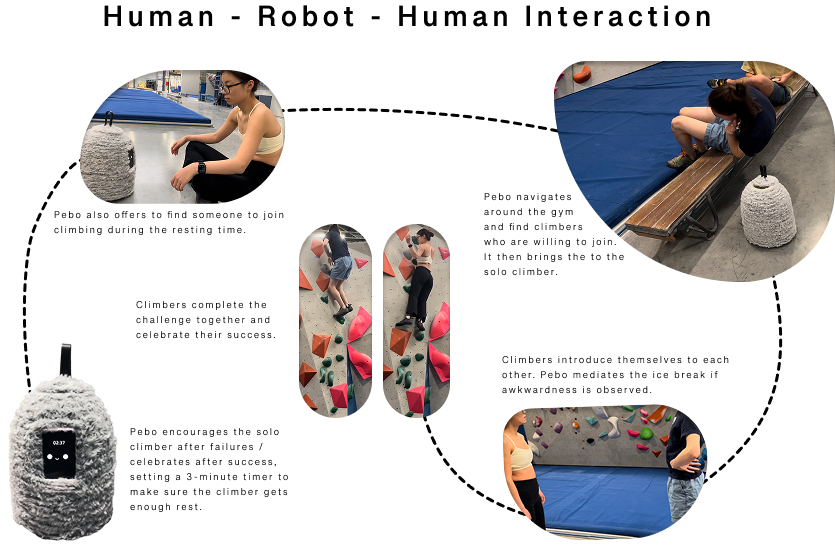
Storyboard
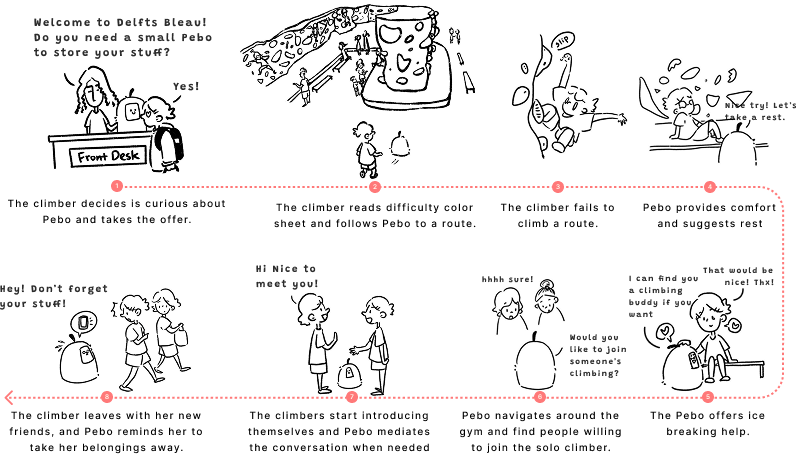
Design Process

Field Studies
Method: Fly on the Wall

This design is located at Bouldercentrum Delfts Bleau, an indoor bouldering gym near the TU Delft campus. Its proximity makes it popular among TU Delft students and staff, with a steady influx of newcomers each year as the university welcomes new members.
The indoor layout, repurposed from a former plant, is a single-floor space with winding climbing areas and large open space.


While valuable items can be stored in a small box at the front desk, some climbers prefer to carry the phone with them during climbing so that they can take photos. Benches are always occupied by phones, bottles, and chalk bags, and some left their belongings unattended at a bench when they go to another bouldering area.
At Delfts Bleau, you always see groups of people gathering together, discussing the climbing routes and cheering for each other.
Between the climbing sessions, climbers usually stand or sit on the bench, facing the wall and watching others climb.


Generative Research
Method: Mood Sheet
I designed a mood sheet to open up conversations in the bouldering gym. Participants only need to put a mark beside each gym’s area to indicate their experiences and feelings. While they marked, I asked them about the reason behind their marking, and they replied orally with details and contexts.


The result of the generative research shows that climbers are frustrated in the following areas:

Climbers express inconvenience in storing their personal belongings. Only small stuff like keys can be locked at the front desk in a small box. Larger items need to be stored in an open locker or carried with the climber.

Climbers feel uncomfortable sitting on the bench because the bench is too low. Some expressed that they would rather stand because the benches are always occupied with people and personal stuff like chalk bags or phones.
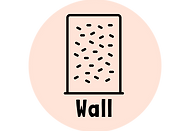
When climbing on the wall, climbers may be frustrated by slippery holds and missing holds, which make it hard to send a route. Beginner climbers also express feeling awkward to climb with strangers watching.
Ethnographic Studies
Method: User Interview
I conducted 5 interviews with climbers of different experience levels in bouldering.
During the interview, I asked questions about their experiences of solo bouldering.

“I’m very motivated to try a challenging line when my friends are there. It’s also easier to ask for help from strangers with my friends.”
. —— Haoran (TUD master, no bouldering experience)

“I usually come with friends. I won’t feel embarrassed to fail simple lines or afraid to try difficult ones when they’re there.”
—— Luna (Prefer not to say, 1-month bouldering experience)

“I almost quit after my first visit (alone) to Delfts Bleau. I couldn’t even finish the easiest levels and thought they were made for taller people.”
—— Lyra (TUD master, 4-month bouldering experience)

“My main problem with solo bouldering is pacing. It’s boring to just sit there waiting. I often don’t take a long enough break before my next try.”
—— Robert (TUD master, 1.5-year bouldering experience)

“Climbers here are always generous with advice and cheer after they see some nice movements from you.”
—— Keven (TUD master, 2-year bouldering experience)
Persona

Solo Climber's Bouldering Journey
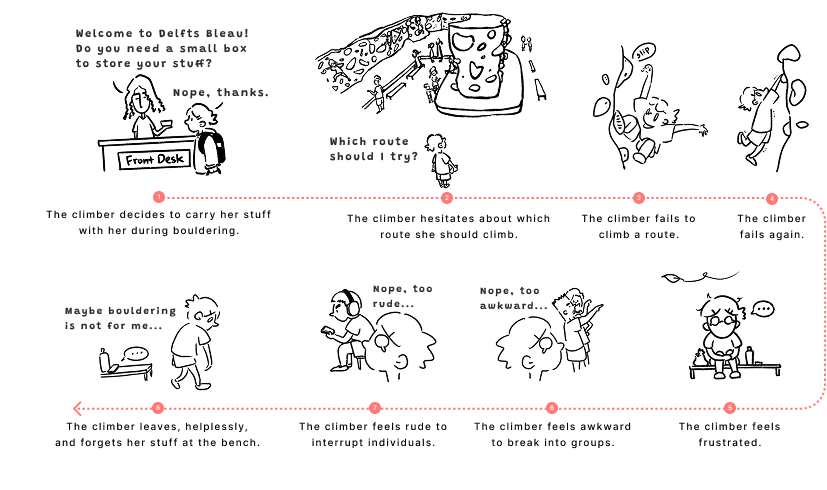
Design Goal
Design an interactive installation
that motivates solo climbers
to stay engaged in the bouldering gym
Design Direction
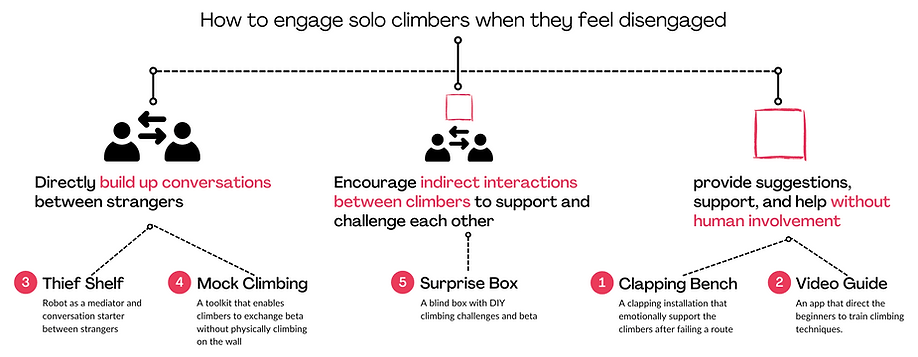
Prototype 1: Clapping Bench
A clapping mechanism that gives highfive on the bench.
A performance is conducted at Delfts Bleau to prototype and test the experience
Feedback from Performance Test
-
The emotional feedback alone doesn’t resolve the helpless feeling and frustration of failing a line.
-
Climbers need more concrete support like advice on how to climb.
-
The climber may not come back to the same bench after climbing.

Prototype 2: Thief Shelf
A moving shelf that will carry the belongings and find new friends for the solo climber.
One user test is conducted at Delfts Bleau.
Negative Feedback
-
Climbers feel awkward to start the conversation after meeting each other
-
Climber feels unsafe about storing belongings on the shelf since the approached strangers may take them away
-
The appearance is confusing and doesn’t convey its function efficiently
Positive Feedback
-
The moving robot makes them feel curious and eager to try
Participant expressed the needs of a mediator who introduces them to new people/climbing communities.
The fact that the mediator is nonhuman creates a safe feeling for people to choose to accept / reject building new social connections
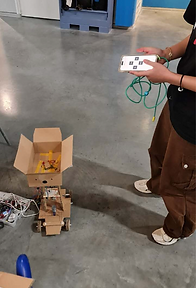
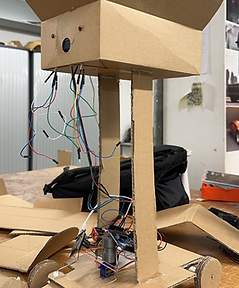
Prototype 3: Mock Climbing Toolkit
A mock climbing board that enables climbers to demo the climbing sequence easily.
One user test is conducted at Delfts Bleau.
Feedback
-
The board is too small and the climber figure is too big, making it hard to navigate the board.
-
The visualization of the lines is in 2D, which misses the 3D information of the wall and boulders.
-
It’s inconvenient to hold the board with one hand and do instructions with another.

Prototype 4: Surprise Box
A community activity where climbers write and share climbing challenges. In return, they can draw a challenge from the box before climbing.
One user test is conducted at Delfts Bleau.
Negative Feedback
-
The lottery experience is too hard and tedious.
-
Sometimes can glimpse the content inside the envelope.
-
The textbox is not effective in conveying the climbing challenges.
-
Feel lazy to write texts.
-
Need some incentive to contribute DIY challenges and beta
Positive Feedback
-
DIY challenges makes the climber think creatively about their climbing process rather than just focusing on the result of climbing
-
The lottery experience provides a surprise and novel feeling, just like the blind box. This helps climbers to stay engaged with the bouldering lines
-
The cards are intuitive and the visuals help the DIY process

Redefined Design Direction

Redefined Design Goal
Design a movable interactive device
that encourages solo climbers
to stay engaged and connected
in the Delfts Bleau Bouldering Centrum
AI-Driven Conceptualization
Tool: Midjourney
I used Midjourney to generate around 50 designs of the robot design concept. I choose the furry one to base my design on because it looks sociable and friendly, making it easier to stimulate empathy when approaching climbers in the bouldering gym.
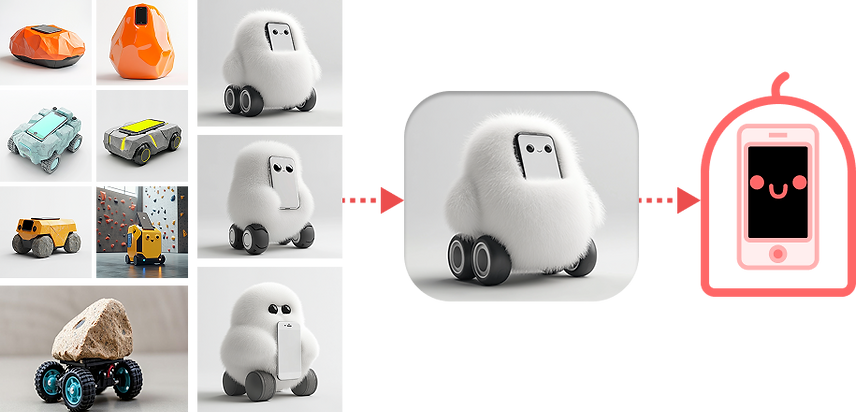
Modeling & Fabrication
I modeled Pebo's shell with Fusion 360. Since the structure is too big for printing as one piece, I split it into eight pieces and printed them separately.

I choose grey-white yarn to simulate the texture of a pika and the color of a pebble. It also covers the 3D printing material’s color (white and grey) better. The yarn is glued to the 3D structure with a hot gun.

Wizard of Oz Tool Development
Tool: Socket.io, ESP32, Web Dev
The interaction on screen is controlled through a web app I made, using socket.io for data transmission and p5.js for visual development.

The robot's motion is controlled by a navigation web page. The control device is connected to the WIFI simulated by ESP32.
Evaluation
In-Context User Test with Junru
It is Junru’s first time bouldering. He decided to try the “randomize route” function and was given a green route. He succeeded on climbing and was cheered by Pebo. Pebo started the timer to ensure he rest enough before the next try. Junru became ambitious after his first success, and decided to try a pink route (level3). He was stuck at the beginning. Pebo found an experienced and extrovert climber who starts the introduction smoothly without Pebo’s instruction. The climber later showed Junru some climbing tricks and Junru learned quickly under his instructions. Pebo stayed silently aside as there was no need to mediate the conversation.
During the test, voice interaction was not used. Junru’s first instinct is to touch the screen and pat Pebo.


In-Context User Test with Lyra Liu
Lyra has 6 months of climbing experiences. After putting her earphone case into the Pebo shelf, she tried the “challenge maker” function and received the challenge “climb with one hand only” on a green route. She attempted 2 times but failed.
Pebo moved to another area and found a stranger willing to join the challenge. After leading the climber to Lyra, Pebo started an ice breaking intro to help break down the awkwardness between the two climbers.

Lyra and this climber introduced themselves and the climber tried the challenge, sending the route at the first trial. Lyra analyzed his movements and tried the challenge again. She successfully complete the challenge. Pebo suggested a high five to celebrate the duo success.
Both participants give positive feedback to the Pebo’s character design, but express difficulty in listening to its voice.

Out-of-Context User Test at Course Exhibition
Evaluation form is distributed after the D2D exhibition and the user tests. 13 responses are collected and analyzed.
Emotional Interaction
During the exhibition and user tests, over 20 people used the word “cute” to describe Pebo.
Other frequently mentioned words are “lovely” and “soft”. Many expressed that they want to pat it.

Emotional Interaction
During the exhibition and user tests, over 20 people used the word “cute” to describe Pebo.
Other frequently mentioned words are “lovely” and “soft”. Many expressed that they want to pat it.
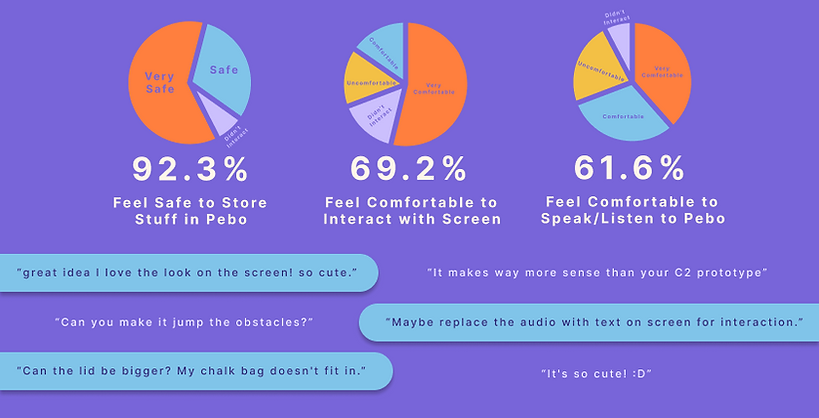
Social Interaction
Positive results are shown from both the survey and the observation:
1) Solo climbers successfully sent the routes after receiving suggestions from their new friends.
2) The climbing challenge function receives strong positive feedback from the tested user.
3) All approached climbers at Delfts Bleau accept Pebo’s offer to join the solo climber. They
expressed that they are curious about it.

Design Result
Pebo fosters connections between climbers with different personalities and experiences while providing a safe, engaging, and motivating atmosphere.

